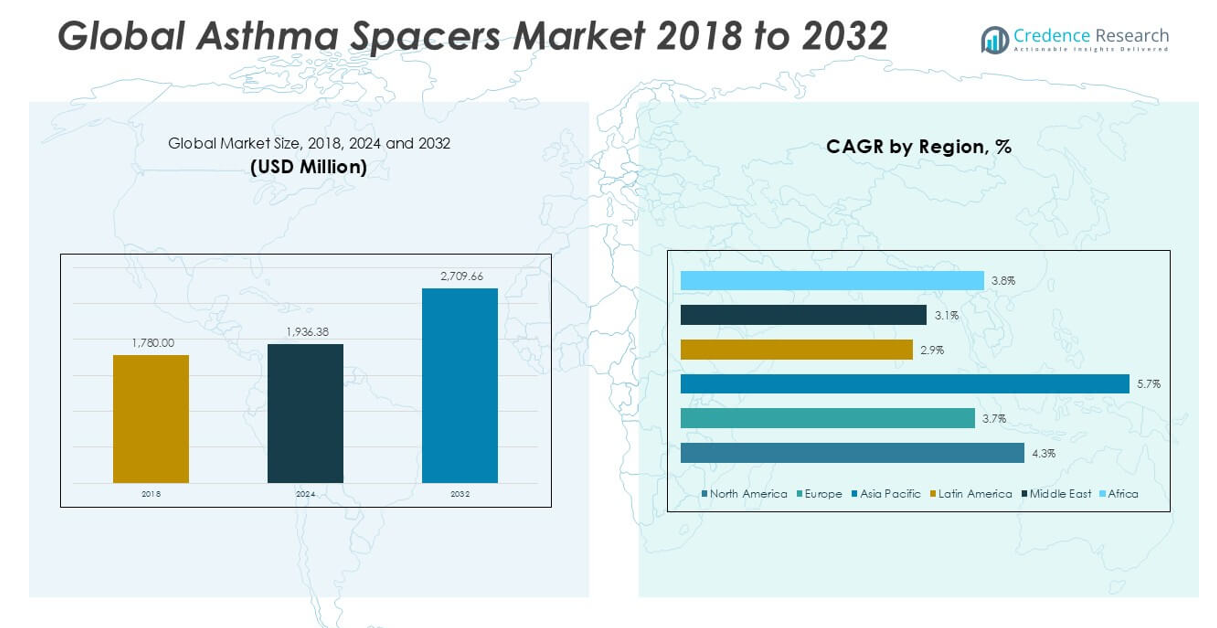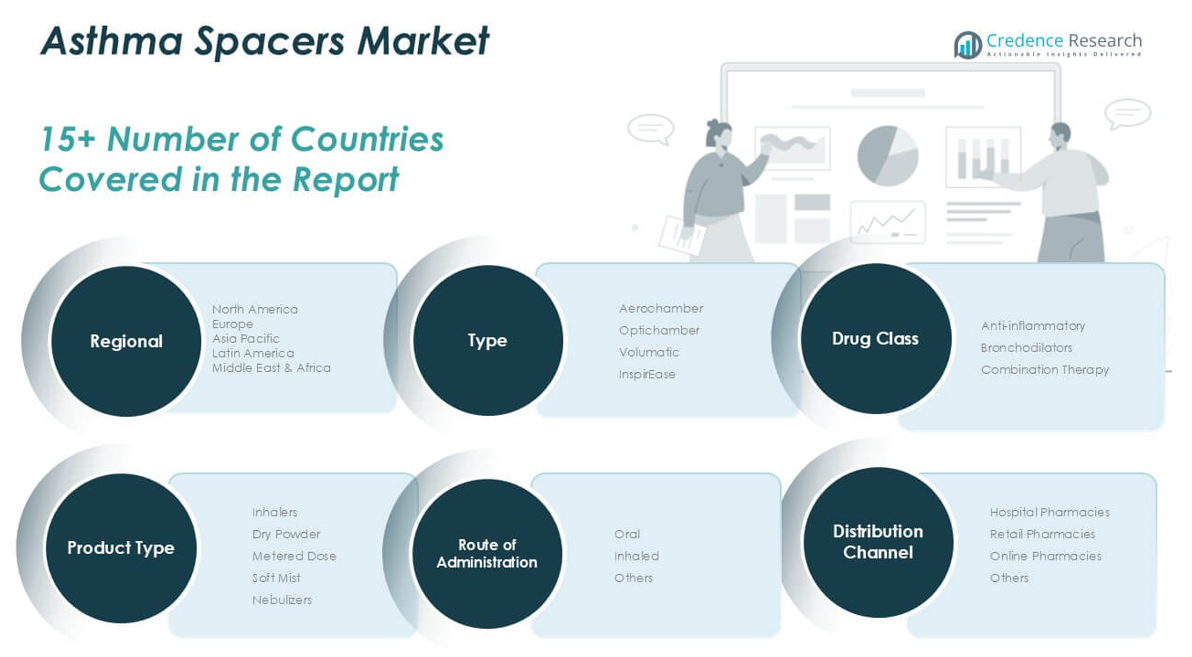CHAPTER NO. 1 : GENESIS OF THE MARKET
1.1 Market Prelude – Introduction & Scope
1.2 The Big Picture – Objectives & Vision
1.3 Strategic Edge – Unique Value Proposition
1.4 Stakeholder Compass – Key Beneficiaries
CHAPTER NO. 2 : EXECUTIVE LENS
2.1 Pulse of the Industry – Market Snapshot
2.2 Growth Arc – Revenue Projections (USD Million)
2.3. Premium Insights – Based on Primary Interviews
CHAPTER NO. 3 : ASTHMA SPACERS MARKET FORCES & INDUSTRY PULSE
3.1 Foundations of Change – Market Overview
3.2 Catalysts of Expansion – Key Market Drivers
3.2.1 Momentum Boosters – Growth Triggers
3.2.2 Innovation Fuel – Disruptive Technologies
3.3 Headwinds & Crosswinds – Market Restraints
3.3.1 Regulatory Tides – Compliance Challenges
3.3.2 Economic Frictions – Inflationary Pressures
3.4 Untapped Horizons – Growth Potential & Opportunities
3.5 Strategic Navigation – Industry Frameworks
3.5.1 Market Equilibrium – Porter’s Five Forces
3.5.2 Ecosystem Dynamics – Value Chain Analysis
3.5.3 Macro Forces – PESTEL Breakdown
3.6 Price Trend Analysis
3.6.1 Regional Price Trend
3.6.2 Price Trend by product
CHAPTER NO. 4 : KEY INVESTMENT EPICENTER
4.1 Regional Goldmines – High-Growth Geographies
4.2 Product Frontiers – Lucrative Product Categories
4.3 Type Sweet Spots – Emerging Demand Segments
CHAPTER NO. 5: REVENUE TRAJECTORY & WEALTH MAPPING
5.1 Momentum Metrics – Forecast & Growth Curves
5.2 Regional Revenue Footprint – Market Share Insights
5.3 Segmental Wealth Flow – Drug Class & Type Revenue
CHAPTER NO. 6 : TRADE & COMMERCE ANALYSIS
6.1. Import Analysis by Region
6.1.1. Global Asthma Spacers Market Import Revenue By Region
6.2. Export Analysis by Region
6.2.1. Global Asthma Spacers Market Export Revenue By Region
CHAPTER NO. 7 : COMPETITION ANALYSIS
7.1. Company Market Share Analysis
7.1.1. Global Asthma Spacers Market: Company Market Share
7.2. Global Asthma Spacers Market Company Revenue Market Share
7.3. Strategic Developments
7.3.1. Acquisitions & Mergers
7.3.2. New Product Launch
7.3.3. Regional Expansion
7.4. Competitive Dashboard
7.5. Company Assessment Metrics, 2024
CHAPTER NO. 8 : ASTHMA SPACERS MARKET – BY DRUG CLASS SEGMENT ANALYSIS
8.1. Asthma Spacers Market Overview by Drug Class Segment
8.1.1. Asthma Spacers Market Revenue Share By Drug Class
8.2. Anti-inflammatory
8.3. Bronchodilators
8.4. Combination Therapy
CHAPTER NO. 9 : ASTHMA SPACERS MARKET – BY TYPE SEGMENT ANALYSI
9.1. Asthma Spacers Market Overview by Type Segment
9.1.1. Asthma Spacers Market Revenue Share By Type
9.2. Aero chamber
9.3. Opti chamber
9.4. Volumatic
9.5. InspirEase
CHAPTER NO. 10 : ASTHMA SPACERS MARKET – BY PRODUCT TYPE SEGMENT ANALYSIS
10.1. Asthma Spacers Market Overview by Product Type Segment
10.1.1. Asthma Spacers Market Revenue Share By Product Type
10.2. Inhalers
10.2.1 Dry Powder
10.2.2 Metered Dose
10.2.3 Soft Mist
10.3. Nebulizers
CHAPTER NO. 11 : ASTHMA SPACERS MARKET – BY ROUTE OF ADMINISTRATION SEGMENT ANALYSIS
11.1. Asthma Spacers Market Overview by Route of Administration Segment
11.1.1. Asthma Spacers Market Revenue Share By Route of Administration
11.2. Oral
11.3. Inhaled
11.4. Others
CHAPTER NO. 12 : ASTHMA SPACERS MARKET – BY DISTRIBUTION CHANNEL SEGMENT ANALYSIS
12.1. Asthma Spacers Market Overview by Distribution Channel Segment
12.1.1. Asthma Spacers Market Revenue Share By Distribution Channel
12.2. Hospital Pharmacies
12.3. Retail Pharmacies
12.4. Online Pharmacies
12.5. Others
CHAPTER NO. 13 : ASTHMA SPACERS MARKET – REGIONAL ANALYSIS
13.1. Asthma Spacers Market Overview by Region Segment
13.1.1. Global Asthma Spacers Market Revenue Share By Region
13.1.2. Regions
13.1.3. Global Asthma Spacers Market Revenue By Region
13.1.4. Drug Class
13.1.5. Global Asthma Spacers Market Revenue By Drug Class
13.1.6. Type
13.1.7. Global Asthma Spacers Market Revenue By Type
13.1.8. Product Type
13.1.9. Global Asthma Spacers Market Revenue By Product Type
13.1.10. Route of Administration
13.1.12. Global Asthma Spacers Market Revenue By Route of Administration
13.1.13. Distribution Channel
13.1.14. Global Asthma Spacers Market Revenue By Distribution Channel
CHAPTER NO. 14 : NORTH AMERICA ASTHMA SPACERS MARKET – COUNTRY ANALYSIS
14.1. North America Asthma Spacers Market Overview by Country Segment
14.1.1. North America Asthma Spacers Market Revenue Share By Region
14.2. North America
14.2.1. North America Asthma Spacers Market Revenue By Country
14.2.2. Drug Class
14.2.3. North America Asthma Spacers Market Revenue By Drug Class
14.2.4. Type
14.2.5. North America Asthma Spacers Market Revenue By Type
14.2.6. Product Type
14.2.7. North America Asthma Spacers Market Revenue By Product Type
14.2.8. Route of Administration
14.2.9. North America Asthma Spacers Market Revenue By Route of Administration
14.2.10. Distribution Channel
14.2.11. North America Asthma Spacers Market Revenue By Distribution Channel
14.3. U.S.
14.4. Canada
14.5. Mexico
CHAPTER NO. 15 : EUROPE ASTHMA SPACERS MARKET – COUNTRY ANALYSIS
15.1. Europe Asthma Spacers Market Overview by Country Segment
15.1.1. Europe Asthma Spacers Market Revenue Share By Region
15.2. Europe
15.2.1. Europe Asthma Spacers Market Revenue By Country
15.2.2. Drug Class
15.2.3. Europe Asthma Spacers Market Revenue By Drug Class
15.2.4. Type
15.2.5. Europe Asthma Spacers Market Revenue By Type
15.2.6. Product Type
15.2.7. Europe Asthma Spacers Market Revenue By Product Type
15.2.8. Route of Administration
15.2.9. Europe Asthma Spacers Market Revenue By Route of Administration
15.2.10. Distribution Channel
15.2.11. Europe Asthma Spacers Market Revenue By Distribution Channel
15.3. UK
15.4. France
15.5. Germany
15.6. Italy
15.7. Spain
15.8. Russia
15.9. Rest of Europe
CHAPTER NO. 16 : ASIA PACIFIC ASTHMA SPACERS MARKET – COUNTRY ANALYSIS
16.1. Asia Pacific Asthma Spacers Market Overview by Country Segment
16.1.1. Asia Pacific Asthma Spacers Market Revenue Share By Region
16.2. Asia Pacific
16.2.1. Asia Pacific Asthma Spacers Market Revenue By Country
16.2.2. Drug Class
16.2.3. Asia Pacific Asthma Spacers Market Revenue By Drug Class
16.2.4. Type
16.2.5. Asia Pacific Asthma Spacers Market Revenue By Type
16.2.6. Product Type
16.2.7. Asia Pacific Asthma Spacers Market Revenue By Product Type
16.2.8. Route of Administration
16.2.9. Asia Pacific Asthma Spacers Market Revenue By Route of Administration
16.2.10. Distribution Channel
16.2.11. Asia Pacific Asthma Spacers Market Revenue By Distribution Channel
16.3. China
16.4. Japan
16.5. South Korea
16.6. India
16.7. Australia
16.8. Southeast Asia
16.9. Rest of Asia Pacific
CHAPTER NO. 17 : LATIN AMERICA ASTHMA SPACERS MARKET – COUNTRY ANALYSIS
17.1. Latin America Asthma Spacers Market Overview by Country Segment
17.1.1. Latin America Asthma Spacers Market Revenue Share By Region
17.2. Latin America
17.2.1. Latin America Asthma Spacers Market Revenue By Country
17.2.2. Drug Class
17.2.3. Latin America Asthma Spacers Market Revenue By Drug Class
17.2.4. Type
17.2.5. Latin America Asthma Spacers Market Revenue By Type
17.2.6. Product Type
17.2.7. Latin America Asthma Spacers Market Revenue By Product Type
17.2.8. Route of Administration
17.2.9. Latin America Asthma Spacers Market Revenue By Route of Administration
17.2.10. Distribution Channel
17.2.11. Latin America Asthma Spacers Market Revenue By Distribution Channel
17.3. Brazil
17.4. Argentina
17.5. Rest of Latin America
CHAPTER NO. 18 : MIDDLE EAST ASTHMA SPACERS MARKET – COUNTRY ANALYSIS
18.1. Middle East Asthma Spacers Market Overview by Country Segment
18.1.1. Middle East Asthma Spacers Market Revenue Share By Region
18.2. Middle East
18.2.1. Middle East Asthma Spacers Market Revenue By Country
18.2.2. Drug Class
18.2.3. Middle East Asthma Spacers Market Revenue By Drug Class
18.2.4. Type
18.2.5. Middle East Asthma Spacers Market Revenue By Type
18.2.6. Product Type
18.2.7. Middle East Asthma Spacers Market Revenue By Product Type
18.2.8. Route of Administration
18.2.9. Middle East Asthma Spacers Market Revenue By Route of Administration
18.2.10. Distribution Channel
18.2.11. Middle East Asthma Spacers Market Revenue By Distribution Channel
18.3. GCC Countries
18.4. Israel
18.5. Turkey
18.6. Rest of Middle East
CHAPTER NO. 19 : AFRICA ASTHMA SPACERS MARKET – COUNTRY ANALYSIS
19.1. Africa Asthma Spacers Market Overview by Country Segment
19.1.1. Africa Asthma Spacers Market Revenue Share By Region
19.2. Africa
19.2.1. Africa Asthma Spacers Market Revenue By Country
19.2.2. Drug Class
19.2.3. Africa Asthma Spacers Market Revenue By Drug Class
19.2.4. Type
19.2.5. Africa Asthma Spacers Market Revenue By Type
19.2.6. Product Type
19.2.7. Africa Asthma Spacers Market Revenue By Product Type
19.2.8. Route of Administration
19.2.9. Africa Asthma Spacers Market Revenue By Route of Administration
19.2.10. Distribution Channel
19.2.11. Africa Asthma Spacers Market Revenue By Distribution Channel
19.3. South Africa
19.4. Egypt
19.5. Rest of Africa
CHAPTER NO. 20 : COMPANY PROFILES
20.1. Trudell Medical International
20.1.1. Company Overview
20.1.2. Product Portfolio
20.1.3. Financial Overview
20.1.4. Recent Developments
20.1.5. Growth Strategy
20.1.6. SWOT Analysis
20.2. PARI GmbH
20.3. Koninklijke Philips N.V.
20.4. GlaxoSmithKline plc
20.5. Cipla Inc.
20.6. HAAG-STREIT Group
20.7. Lupin Limited
20.8. Medical Developments International
20.9. Visiomed Group Ltd.
20.10. Rossmax International Ltd.
20.11. Teleflex Incorporated
20.12. Monaghan Medical Corporation
20.13. Asia Connection Co., Ltd.
20.14. AstraZeneca plc
20.15. Mediacare Equipments (India) Pvt. Ltd.





